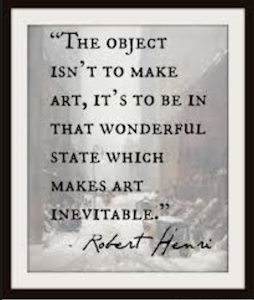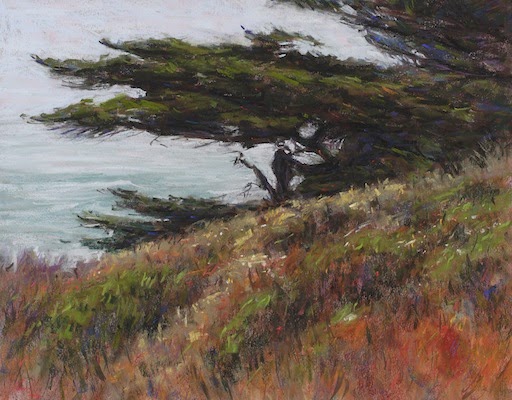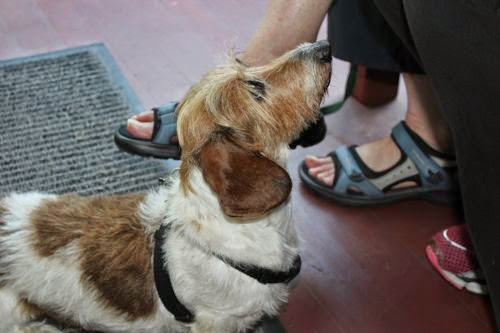One of our most popular instructors, Koo Schadler, returns to the Hudson River Valley Art Workshops this Spring. Koo’s Egg Tempera Painting II Workshop will be held April 24 to 30, 2016. This comprehensive five-day workshop, taught by an internationally recognized tempera painter, offers the opportunity for in-depth work in egg tempera: students will spend five full days working on a painting of their own design.
Koo shared some insights on her style of teaching, and her creative process with this unusual and timeless medium.

How long have you been teaching and what got you started teaching?
Shortly after my first solo exhibition a local art center asked me to teach a workshop. There are not many full time egg tempera artists and even fewer who teach the medium, and they were excited by the possibility of offering a class in tempera. I had neither considered nor knew anything about teaching – a complete beginner! But I took to it immediately, learned a lot and loved it. That was 20 years ago. In the intervening years I’ve taught workshops (several every year) all over the US and abroad. It is one of the most rewarding parts of my career.

What is your favorite part about teaching?
Taking a workshop requires time and resources, and speaks to a person’s commitment to his or her artwork. I’m very impressed by this so it’s important that, in return for making the considerable effort to attend a class, a student goes home with clear, practical ways to strengthen their technique and imagery. My favorite part of teaching is giving students concrete, specific skills and as a consequence seeing immediate improvement in their work.

What would you tell your prospective students are three best reasons for taking a workshop?
1. No matter the subject matter or stylistic preferences I’m confident I can help a student improve. I believe one of my strengths as an instructor is the ability to diagnose and solve problems. I’m practical in my approach. I don’t offer vague concepts or clever aphorisms. I give specific solutions, both technically (how to light subject matter, mix colors, turn a form, etc.) and in design (how to arrange values, colors, shapes, etc., into a compelling image). I’ve had many students with MFA degrees tell me they learned more at one of my workshops than four years of art school. I don’t mean that in a boastful way, only to affirm that I teach useful, applicable skills. If a student is willing and able, I’m confident he or she will leave my workshop a more capable painter.
2. A room of a dozen or more painters offers an incredibly diverse range of skills, ideas and perspectives. I have learned so much from my students! In addition to what I offer, students invariably are inspired by and learn from one another.
3. Contrary to its reputation, egg tempera is not solely about meticulous, fussy brushwork (although, for those who enjoy fine brushwork, there are plenty of opportunities!) I teach a wide range of working methods. Expressionistic, loose painters like the splattering, faux finish demonstration, crafty painters get to work with stencils and rubber stamps, traditionalists learn about under paintings and glazing. I tailor the curriculum to suit each student’s individual nature and goals. In short, amidst the challenge of learning a new medium, I make sure everyone has a rewarding and genuinely fun week.
 What are you currently working on in your own art?
What are you currently working on in your own art?
Tempera is a relatively slow medium. Creating enough paintings for a solo exhibition takes time, which means I will spend this entire year working exclusively for a solo show at Arden Gallery scheduled for December 2016. I currently have two triptychs (three-paneled paintings) on the easel, each with a fairly ambitious and complex composition. These two pieces should keep me fully occupied for a couple of months, at least.
Where is your art currently being exhibited?
This winter I have a silverpoint drawing in a group show at the Morris Graves Museum of Art in Eureka, California. Arden Gallery in Boston, which represents my work on an ongoing basis, is featuring a mini show of my paintings this winter as well. I have a larger solo show planned at Arden for next December.
Is your work represented in galleries?
The J. Cacciola Gallery in NYC has represented my work for over a decade. Arden Gallery in Boston has also shown my work for many years. About once a year I send one or two pieces to a gallery hosting a special event; for example, I’ve participated in M. A. Doran Gallery’s Annual Realism Invitational a few times. I also often have work in various museum shows, such as a solo exhibition at the Huntington Museum of Art last year, and a piece in the silverpoint drawing show currently at the Morris Graves Museum in California.
What hints would you give to artists looking for gallery representation?
Before trying to get a gallery, an artist should be sure he or she can produce a consistent body of work, frame it properly, get it photographed, have a sense of how to price it, etc. Don’t go in with amateur skills; a good gallery wants to work with a pro. Look for galleries where your work fits, both stylistically and pricewise. Make sure they are reliable and have a good reputation (which you can learn by talking to other painters). Find out the gallery’s submission guidelines and follow them precisely. Galleries get scores of requests from artists; a good way to stand out is a personal reference (such as a friend who shows there). Once you have a gallery be sure you understand their terms and expectations, and ideally get it in writing (i.e. a signed contract). In return for promoting and selling your work a gallery takes a commission, often 50%. A good dealer earns and deserves it.
If you aren’t quite ready to enter the gallery world, a good warm-up act is to organize a show yourself. It could be either a solo or group show, but if you can produce enough work I suggest going solo – no problematic group dynamics, and then you are responsible for everything: producing a body of work, framing and photography, advertising, pricing, organizing the opening, etc. Start modestly and pick a local venue such as a café, library or community art center. A relatively low-stakes solo show is excellent practice to see if you have the interest, ability and discipline to not only produce a body of work, but also attend to the various tasks required to market and sell it. It demonstrates to galleries that you are serious and is a helpful addition to your resume.

Do you sell your work in any online gallery?
The galleries that represent my work all have a presence online. I prefer to leave marketing and sales to the galleries so I can spend more time at the easel!
What is your favorite art quote?
I have many beloved art quotes, posted all over my studio. My favorite is by Cennino Cennini, a 14th century painter. In his treatise “The Craftsman’s Handbook” he wrote,
“Begin by adorning yourself with these vestments: love, reverence, obedience, and constancy.”
In my experience these traits are precisely what is required to succeed as a painter.
Michelangelo was a poet as well as a sculptor and painter. Among his many quotable lines, I especially love this one: “Beauty was given at my birth to serve.” I too feel in service to the mysterious, demanding, wonderful job of being an artist.

My Studio
My husband Jeff and I spent many years moving from house to house (because for a time he worked in renovation) so in my twenty-year career I’ve had fourteen studios. They ranged from a 1000 sq. foot warehouse space to a 4’ card table; heated and unheated; with and without water; visual delights to utter eyesores (including two dusty, moldy, spider-filled basements!) At this point I have a wonderful studio, which undoubtedly helps with my concentration, contentment, and production as an artist. Still, with sufficient commitment and determination I’ve found it’s possible to paint almost anywhere.

Right now I actually have two studios. For eight months of the year we live in New Hampshire. Jeff designed and built a beautiful studio building as well as the furniture within that keeps the space organized (such as my blue pigment shelf, tailored to various-sized jars). My NH studio is fully stocked: art supplies and tools of every kind, a large library, copy machine and printer, desk, long work table, a couple of sinks for clean up, shelving to display work in progress. It’s a great environment and I get a lot done in it.





From December to March we live in a small village in the mountains of Michoacán, Mexico, where eight years ago we bought and restored an old adobe fixer-upper. The property came with a concrete outbuilding that serves as my winter studio. It is a small, spare room stocked with the bare minimum: a desk and chair, painting supplies, lights – that’s it. From my perch I look out on a courtyard of flowers (jasmine, gardenias, roses) and citrus trees. Despite its simplicity, my Mexico studio is also a great environment and I get a lot of work done there too!





 Because the first day of the workshop was Halloween, the breakfast special of the day was pumpkin pancakes! Of course, the full breakfast menu was still available with a wide range of choices.
Because the first day of the workshop was Halloween, the breakfast special of the day was pumpkin pancakes! Of course, the full breakfast menu was still available with a wide range of choices. 



 Monday night, for dinner, a number of people got in the Halloween spirit and dressed in costume!
Monday night, for dinner, a number of people got in the Halloween spirit and dressed in costume! 





 Thanks to Carol E. we had a bunch of options for those who “forgot” to pack a costume!
Thanks to Carol E. we had a bunch of options for those who “forgot” to pack a costume! 



 It was quite the marvelous week and there was even plenty of Fall colors around the grounds to be enjoyed.
It was quite the marvelous week and there was even plenty of Fall colors around the grounds to be enjoyed.  It was a satisfying and inspiring year of workshops. We thank everyone who made it possible – students, teachers, and staff. We look forward to another exciting year in 2017. The classes are already filling up and we haven’t even sent out the brochures yet. Keep warm and we’ll see you next year!
It was a satisfying and inspiring year of workshops. We thank everyone who made it possible – students, teachers, and staff. We look forward to another exciting year in 2017. The classes are already filling up and we haven’t even sent out the brochures yet. Keep warm and we’ll see you next year! This is a cold wax piece in the works by one of the artists who comes every year. He says this place is “his muse” and is always preparing for a show when he comes to the retreat. When he returns the next year, we get the report of all his paintings that have sold that he created at the retreat.
This is a cold wax piece in the works by one of the artists who comes every year. He says this place is “his muse” and is always preparing for a show when he comes to the retreat. When he returns the next year, we get the report of all his paintings that have sold that he created at the retreat.  Here we have the work of the first of the “dueling painters”. This woman would go out early in the morning and paint outdoors at some of the wonderful locations in the area.
Here we have the work of the first of the “dueling painters”. This woman would go out early in the morning and paint outdoors at some of the wonderful locations in the area.  Then this painter would ask us for a photo of the same location from our extensive files and he would gleefully paint the same scene while remaining in the air conditioned studio with coffee, lunch, and cookie time just a short walk away.
Then this painter would ask us for a photo of the same location from our extensive files and he would gleefully paint the same scene while remaining in the air conditioned studio with coffee, lunch, and cookie time just a short walk away.  And speaking of food, everyone enjoyed the maple soy salmon on one of the nights.
And speaking of food, everyone enjoyed the maple soy salmon on one of the nights. 



























































































 Where is your art currently being exhibited?
Where is your art currently being exhibited?




























